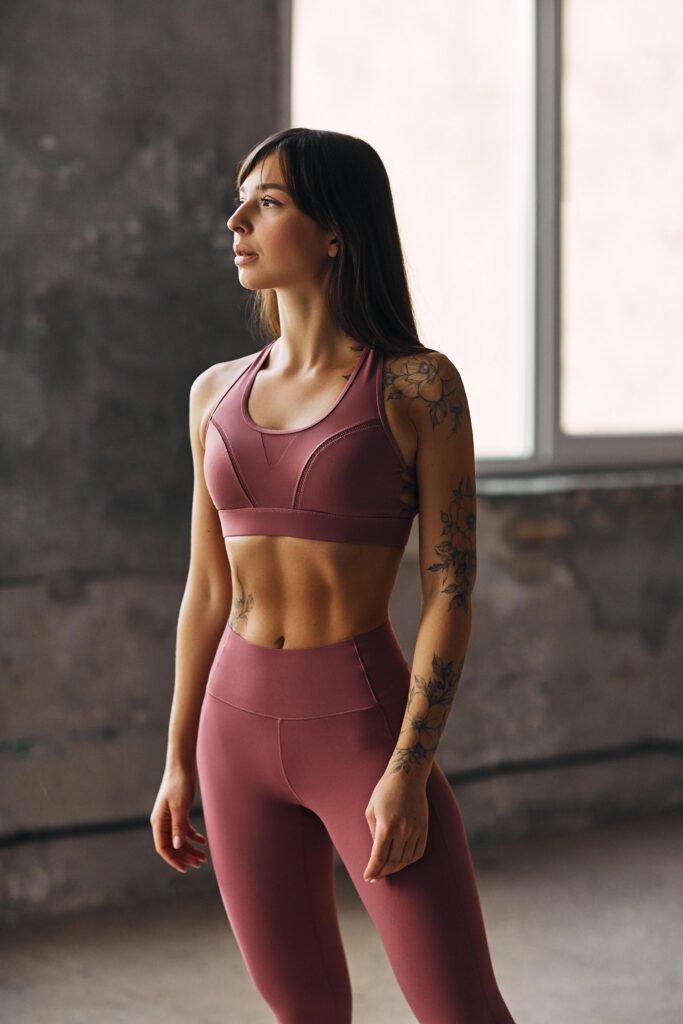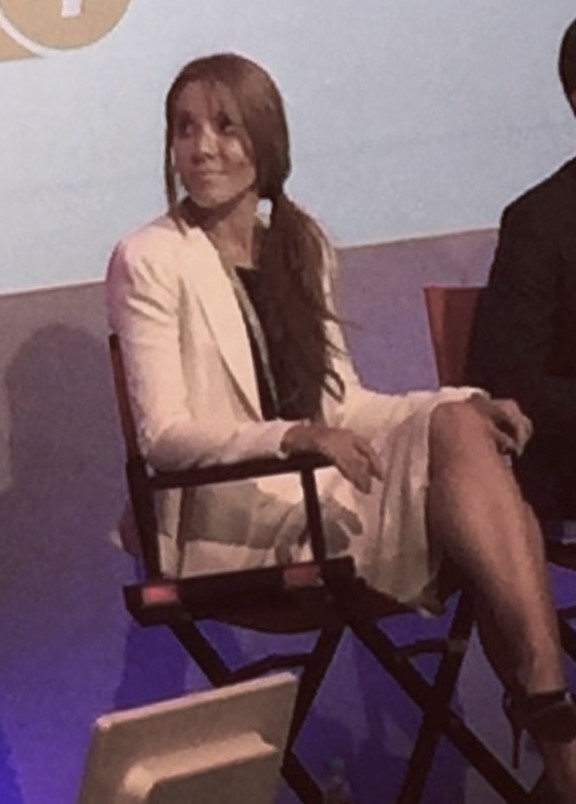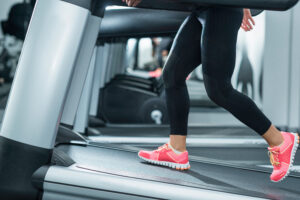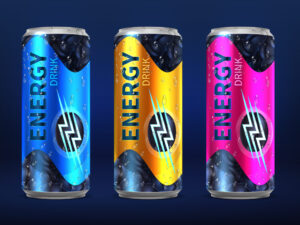If you are looking to lose weight, cardio is a necessary part of the equation. Strength training alone will not cut it. Most of us need a structured program, for that, as well as the RIGHT type of cardio. So what is that? Read this to find out!
Most of the apps we have reviewed so far focus on strength or body weight training, with cardio layered in, or even optional. With these programs, you can also lose fat, but at the same time will likely gain muscle, which may result in no net weight loss or even weight gain. Ever hear complaining (or complain yourself) that you are working your butt off in the gym, and then your clothes size and weight is creeping up? WTF, right ?!
If you want to lose overall weight and shrink in size, there are two programs that are tailored to focus on this – Rachael Attard and Mission Lean.
What’s the skinny?
- If you are looking to focus on fat loss, or to reduce muscle size, especially in the legs, you will want to consult the Mission Lean or Rachael Attard programs.
- Both are simple approaches based on a hybrid of bodyweight training, HIIT, and steady-state low intensity cardio, plus bodyweight training.
- If you are more pressed for time, Mission Lean’s workouts average about 30 minutes.
- If you are coming back to exercise after a long hiatus, or prefer more walking, Rachael Attard’s “Lean legs” program is probably a better choice. The program relies heavily on steady state walking and more Pilates-based movements, with limited high intensity cardio.
- Both programs are more simple than other apps, with interactive PDFs for guidance. They both provide short videos demoing every move, if you need some more guidance up front.
- Both focus on high rep, low or no weight toning, moves, HIIT, and put a heavy emphasis on cardio.
This category does not mean that the other apps or programs are not good for fat loss. The common denominator of the two featured programs - the Mission Lean and the Rachael Attard program - is that they FOCUS on weight loss and overall reduction in body size, including muscle mass and excess fluids.

Photo by Julia Rekamie 
Types of cardio focused on- LISS, MISS, and HIIT
The types of cardio that the Rachael Attard and Mission Lean programs focus on are LISS, MISS and HIIT.
- LISS is “Low intensity steady state” workout. This refers to workouts like power walking, swimming, the elliptical, and low impact cycling.
- MISS is “Medium intensity steady state” workout. This refers to slightly more intense cardio like jogging or rowing.
- HIIT is High intensity interval training. This kind of workout is done in short bursts of “all out” activity, like sprinting or bodyweight training, including movements like burpees, mountain climbers, and high knees, which all raise the heartrate high in a short period of time, followed by a shorter recovery period. You basically should be breathless from doing any type of HIIT workout.
Why muscle loss may be a business decision
Muscle size is also an issue for a lot of us when we really get into going to the gym, and other activities, like spinning. When I was doing a lot of squats and deadlifts in the gym, as well as a lot of spin classes, I noticed that my legs, particularly my thighs and quads, were getting bulky. After doing some research, I realized I was not alone. Watch the video with Mike Matthews of Thinner Leaner Stronger (which I review in this post) explaining the issue. You can read my review of his book in an earlier post. Also, watch trainer Katie Corio talk about how she lost the muscle she bulked up during her power training.
This wasn’t about aesthetics. In the (normal) business environment, the attire for women is fitted pantsuits, tailored pants, pencil skirts, and fitted blazers. We live don’t live in spandex all day. And eventually, once lockdown is over, this brief interlude of wearing yoga pants can actually backfire because of the false sense of security from the stretchy material.
This complaint about clothing fit doesn’t just apply to work attire. I hear it a lot about for skinny jeans and zip-up, boots, as well. After all that feedback, I investigated CICO and fasted cardio.
Fasted cardio
Both the Mission Lean and the Rachael Attard programs pair with the “Calories in Calories out” CICO method, which we talked about in the DAO of metrics. By doing cardio as the first workout first thing in the morning, this argument goes, the body is put in a fat burning state because it already is in a caloric deficit. Thus, it needs to rely on burning fat for energy. The linked article explains why this is a good hack for women that want to have problem low back or thigh areas (like a “muffin top.”)
There is a lot of debate on this topic. If your goal is totally just to lose fat and weight and you don’t care what effect that has on your lean muscle, this could be a viable strategy. But definitely check out my post on pre- and post-workout nutrition for the downsides of fasted working out.

Rachael Attard Lean Legs – the other “Aussie” program
Rachael Attard, like Kayla Itsines of SWEAT (see app review HERE) , is another well-known Australian trainer, is the founder of the “Lean Legs” program. According to the philosophy of this program, certain types of workouts, like spinning, squats, or any weight-bearing exercise involving the legs can cause unwanted bulkiness for women, especially with certain body types. Lots of “power walking,” cardio-focused workouts followed with short stints of plyometrics and strength training can counteract this bulkiness and lean legs out
Power walking as a foundation
Rachael Attard’s mission statement on her site is “I help women get slim and toned bodies, without getting bulky.” The pillars of her program are low-intensity cardio (primarily working), the “correct” type of resistance training and HIIT moves. The walking, she states, can help alleviate some of the “overbulking” of muscle in women’s legs from the wrong types of strength training workouts. In fact, she has you doing 45-minute power walks up to 5 times a week.
At first you may be skeptical – I was. Power walks are for gossiping senior citizens, not real athletes, riiiight? Wrong. Walking is the best exercise you can do consistently and get overall body results. You just have to get over yourself.
What body type you are can determine what the best program is for you
As you can see from the screeenshot of the site, she has a bodytype quiz to determine whether you are an ectomorph (already tall and lean), mesomorph (more in the middle, and muscular) or endomorph. The questions ask things like whether your body is pear shaped, rectangle, or hourglass, where you tend to gain weight, how your jeans fit. The quiz revealed that I was a lovely “endomorph” (see screenshot below). If you are confused about whether you an hourglass or a pear (which is easy to confuse) you can read this article.
Based on body type, your workouts needs are different. For example, an ectomorph, who already has a lean and long body type, has a hard time putting on muscle; whereas mesomorphs and endomorphs gain both muscle and fat more easily. The recommended guidelines for mesomorphs are here; for endomorphs are here.
I have also linked an article in the resources section at the bottom from the National Association of Sports Medicine that gives more info on body types. This taxonomy applies to both men and women.

Format of Program
The program is technically not in an “app” but instead captured in a large PDF with a daily schedule of walking / running and resistance moves. You can order the PDF from her website and download it as a iBook on your phone. It is designed to run eight weeks, and she offers a full refund if you send before and after pics.
The first part of the PDF effectively “sells” her rational of cardio with light resistance training being superior to exercises like squats and deadlifts for weight loss. She then explains that certain types of cardio and resistance training (squats, deadlifts, lower-body HIIT, incline treadmill walking, and cycling) can bulk up your legs. Finally she explains the format of her program, and her type of recommended resistance training
The PDF then provides an outline of the program and individual tear sheets. The PDF is interactive, so you can click on the video link she has for each circuit workout. Recently, she has adjusted them to be in a format where you can follow along live like a regular workout video. You can find an example of one of the resistance training workouts, here.
Rachael also has a lot of this content on her blog. For example, she explains the difference between weight loss and fat loss. She provides guidance for women who have either goal. In a nutshell, the type of workout and diet you choose will differ based on your goals. If you are focused on building lean muscle and fat loss, more resistance training is recommended. If weight loss and shrinking overly bulked muscles is your priority, then you will want to still do resistance training but make adjustments, including incorporating A LOT more cardio.
Difficulty level
The format of Rachael’s program is not as demanding difficulty-wise, but demanding timewise. She has it set up with a morning 45 - 60 minute ”power walk” and then a circuit or a jog in the afternoon. The circuit only takes about 15 minutes, while up to 20 minutes of jogging are recommended. She also has one HIIT circuit a week, but cautions that the right type of HIIT is important for a more lean look. Regular lower body type of HIIT exercises (like burpees) can easily bulk up your legs.
The program can be tweaked depending on where you fall in the body type quiz. For example, if you are a mesomorph, you are advised to keep cardio front and center, lift heavy only for the upper body, and incorporate high-intensity cardio and HIIT. While HIIT is recommended, it is also recommended that you avoid anything that is too targeted at your lower body, which can gain muscle easily. High intensity cardio in this context means running and interval running training (e.g., alternating fast running with walking, but not fully sprinting.). So the workout plan for a mesomorph would look like:
- Resistance training 3 times per week (can include some HIIT)
- High-intensity cardio 3 times per week
- Power walking at least 5 times per week
- One rest (or active) recovery day per week
This is exactly what my trainer recommended to me when I was getting in shape for my wedding and in a cutting phase.
If your quiz revealed that you are an endomorph, you are advised to keep resistance training light and mostly focused on more low-impact cardio as opposed to interval training, which can bulk up your legs easily (see below).

Positives
If you already are an avid walker, this program is good for you. All you would have to do to modify your routine is incorporate some bodyweight training, which could be done in less time than it would take to do a workout on the the other “female fitfluencer” apps like SWEAT. If you like to lift weights, and have trouble incorporating cardio into your program, I would recommend Rachael’s walking program as a way to deload for a few weeks.
It is worth trying this to see what happens, if you are only gaining muscle and are not losing fat, or working out constantly but unhappy with the scale/the way your clothes fit. What can ends up happening if you attend to strength training and overeat is that you will put on muscle through strength training, but it will simply be muscle developing under unwanted fat. In the leg and hip area, this is particularly problematic because unless you are 5’10 or over, this is typically where we get unwanted bulk.
Possible Alternative if undesired results from SWEAT
I have noticed that women who have complained that the SWEAT programs have bulked them up too much have actually defected to Rachael’s program to balance that unintended effect. As I learned, you have to monitor how your body responds and make appropriate adjustments to your cardio and strength training regimes. For example, when I follow the SWEAT plan, I always do LISS before my strength training portion, and avoid the weigh-bearing leg exercises (like heavy squats). You can read my review of Kayla’s SWEAT app here. Rachael herself reviews the program and explains how it may need adjustments based on your goals, here. It’s not impossible to combine the two, if you want to incorporate more LISS into the SWEAT program.
Drawbacks
While Rachael’s program is effective, and relatively easy to follow, it does take a time commitment. That 2-a-days schedule is a lot for busy people who can barely fit in their exercise, so she offers some advice in response to that question – do the circuit training/jog ahead of the walk in the morning if you don’t or can’t work out twice a day. In this instance, she recommends tracking your steps to make sure that you get at least 10K a day.
Also noticeable is there is no actual “app.” While I like her renegade approach, I think that would deter some people especially now that we are all spoiled by AI-friendly apps.
If you live on the east coast or central region, especially in the mid-Atlantic or mid-west, or Canada(!) you really need an indoor walking solution. Walking extensively outside in 20 degree or below weather is not a great option. This is clearly easier if you have regular access to a gym. If not, or if you are still in a COVID holding pattern, you may want to consider investing in a treadmill. Depending on brand and what kind of features you want, you can get a treadmill for between $500-3000. If it’s mostly just for walking, however, you don’t really need to put much of an investment. If space is an issue, NordicTrack has a folding treadmill option for about $1400, and you can order others like from Echelon fit at a comparable price.
Especially if you have a treadmill, you can learn to walk in the morning while reading emails on a tablet or phone. This is what I do. I also do this while I am on some of my morning work calls using my bluetooth speaker. This is especially accessible in a period where most of us are still working remotely. To have a good eyeline, I would recommend that you buy one of these type of racks you can put over a treadmill. Also do get some practice power walking on a treadmill, before you do this, to avoid unintended consequences. And do not try this while running!

Mission Lean
The Mission lean app is co-founded by a former model and a former Harvard pro tennis player (Lyudmila Bouzinova and Jon Perlman). This background alone and co-ed team teaming approach make the program unique from the start.
Through the video on their app, their blog, and other media, the two co-founders of the app strongly advocate a cardio-focused approach supplemented by bodyweight training to get the best results for a lean body. First, the recommend starting each bodyweight workout with a 10-minute jog, and doing cardio interval training on a treadmill, bike, or track every other day. Realistically, not everyone has access to a track but for this purpose I view a treadmill or outdoor running as a good substitute.
The programs include a “Tone up” with Lyuda and a Get Strong with John. They also have programs geared towards athletes, like tennis, lacrosse and baseball. They are organized by week and have a workout or rest day for each day of the week. The workouts alternate from bodyweight circuits one day to cardio intervals the next day, on an every other day schedule.
Besides the exercises, the app has a separate warm up and cool down program that you use around each workout. The trainers emphasize the importance of doing both, especially stretching, to keep a lean physique.
One day a week is for low-intensity training (e.g., LISS) and one day a week is rest. Like Rachael Attard’s app, there are demo videos for all of the moves, and then a PDF of all of the moves. Which is very useful, because you can take a screenshot and make it your home screen on your phone, as I have done. That way you can easily see what you have to do.
Positives
The Mission Lean program days do not take as much time as the Rachael Attard program. With the cardio/running incorporated, each of Mission Lean’s workouts only take about 25-30 minutes max.
Drawbacks
The track training is not really an option for a lot of people. Also, interval training may not be right for all body types. The workouts are not as customized by body type.
The app also suffers from technology flaws. I often have to restart it because the videos or PDF fails to load.
Which program to choose?
I recognize that some of these programs can attract some controversy. So can intermittent fasting, which I cover here. But you know what? Both of them work for certain goals and certain fitness types. Part of it is actually reading the material carefully and not characterizing it as saying cardio is the only way to lose weight or that strength training is bad. It’s not. It’s just that any strength training program needs to be carefully tailored based on one’s goals and that is what she does.
Also, if being muscular regardless of size is your idea of being fit, that is great. It’s all in the eye of the beholder. I was happy with the way I looked in the picture above to the far left, but I felt more comfortable in my skin in the middle picture and the picture on the right. And that’s largely the idea.
I really think the driver of which app depends on how much time you have, and how much weight/size you want to lose.
You should choose Mission Lean if:
- You are more in maintenance mode or have little weight/size to lose.
- You want to finish your workout in half an hour
- You will achieve your CICO moreso by cutting food calories
- You don’t mind a lot of interval running or jumping and your body type won’t bulk up from that
You should choose Rachael Attard if:
- You have more weight to lose
- You want to significantly reduce leg size and overall body size
- You can do two-a-days (but you don’t have to)
- Thighs, calves, abdomen, and hips are your biggest problem areas, and no matter what you do, you can’t lose weight there.
More
- NASM discussion of body type
- Mission Lean Instagram and Introductory Youtube video
- Mission: Possible (Boca magazine)
- Mission Lean mode leg workout
- Harper’s Bazaar: Is spinning making you fat?








